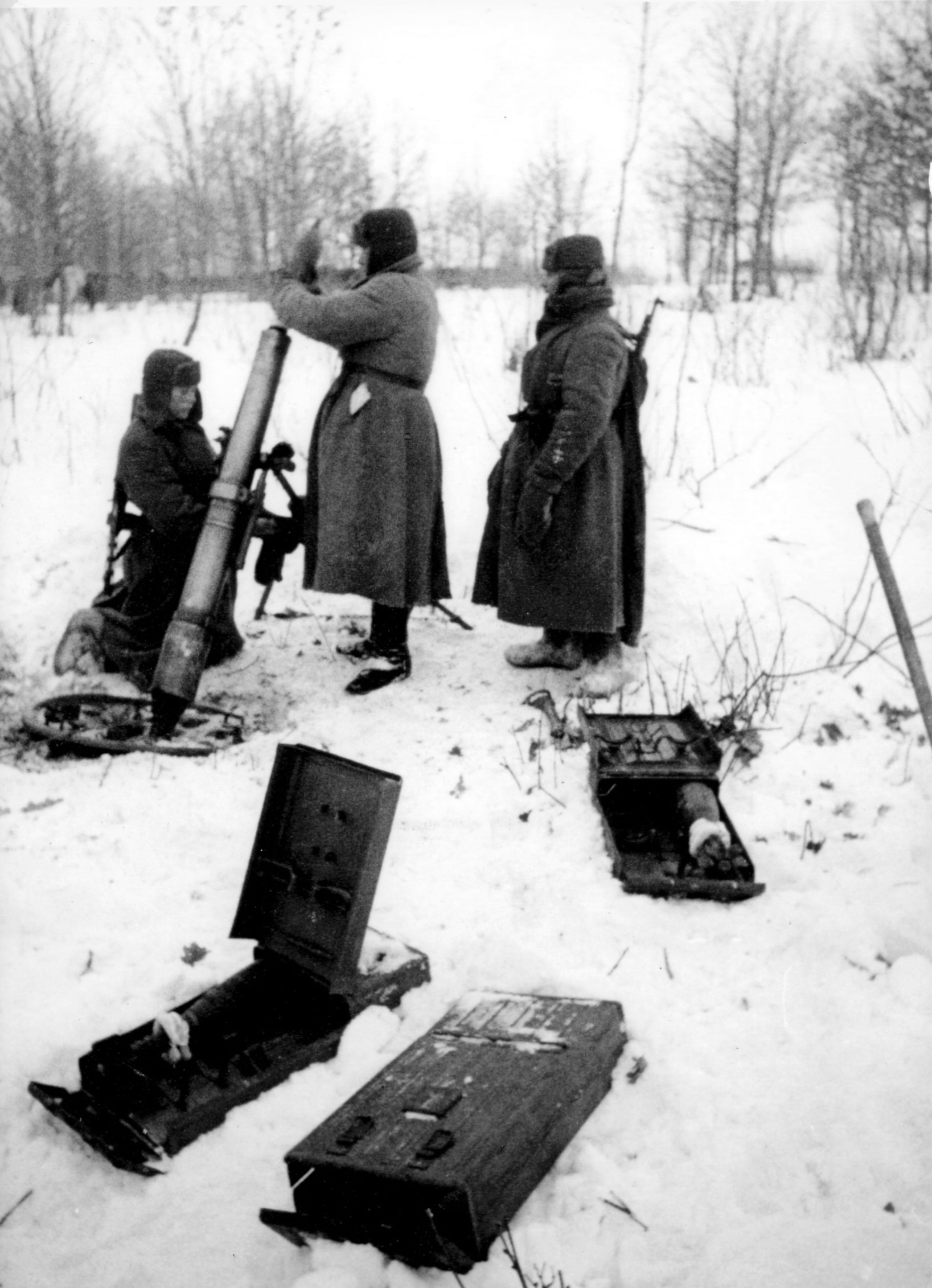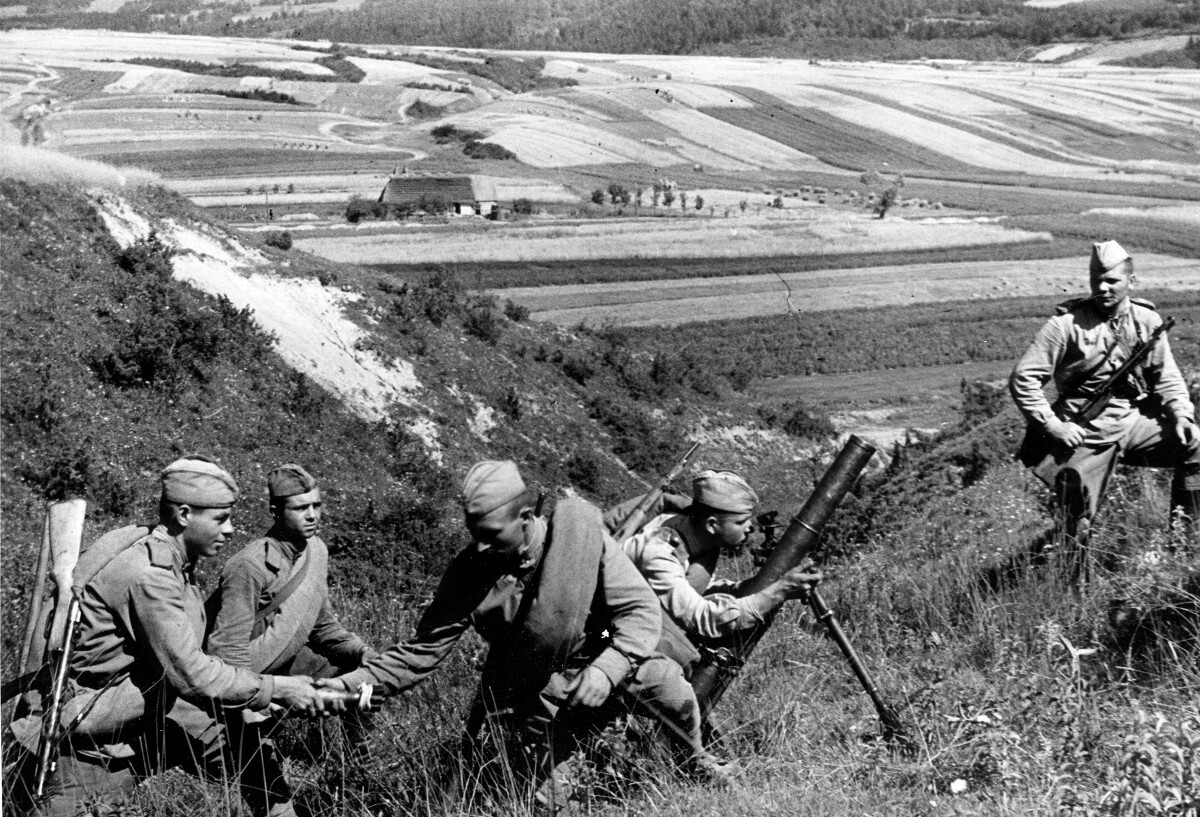The Book of Armaments:
Soviet Heavy Mortars
by Mike Bennighof, Ph.D.
July 2021
 There is no modern war without mortars. A wonderful thing, the mortar. There is no modern war without mortars. A wonderful thing, the mortar.
- J.V. Stalin
The Red Army of Workers & Peasants came relatively late to the concept of mortars. The old Imperial Army had used them during the Great War, but none of the factions deployed them very widely during the Russian Civil War. A design bureau known as Group D, part of the Red Army’s chemical warfare establishment, fashioned a number of mortars designed in the late 1920’s, both light mortars suitable for direct infantry support and heavier ones for use against fortifications, but none of these were approved for prototypes.
But in 1929, the Red Army fought against the Chinese warlord Zhang Xueliang over control of the Chinese Eastern Railway which crossed Manchuria. The Red Army pushed the Chinese around with little effort, and captured large stocks of weaponry including a number of French-made 81mm Brandt mortars. These were passed to Group D, a weapons design team within the Chemical Warfare branch. They worked to reverse-engineer the rather simple design to craft not only a copy of the 81mm mortar but a whole family of lighter and heavier mortars as well.

A 107mm mountain-pack mortar in action outside Moscow, winter 1941-42.
That family included 50mm company mortars, 82mm battalion mortars, 107mm chemical and mountain mortars, 120mm regimental mortars and eventually 160mm divisional mortars. When the Red Army finally adopted mortars, it did so in a big way.
Group D began with the 107mm chemical mortar, this being the root of their design brief. The Soviet Union had a massive chemical weapons program before the war, but apparently relied mostly on the Red Air Force to deliver the payloads. A variant of the chemical mortar, the 107mm mountain-pack mortar was accepted in 1938, with production beginning the next year. A mountain rifle division had two six-tube batteries of mortars in its light artillery regiment, in place of light howitzers. It could be broken into nine loads (including ammunition) or transport by pack horses, or towed behind horses or a light truck on a two-wheeled trailer.
Group D moved on from the chemical mortar to their most widely-used creation, the 82mm battalion mortar. While many sources claim this slightly different caliber was to assure that Soviet crews could fire enemy ammunition, but enemy crews could not fire Soviet ammunition, it’s more likely that Group D initially made their mortar slightly larger than the 81.4mm standard of their model to assure that the mortar bombs would slide smoothly through the tube.

A Soviet crew with their Model 1941 82mm mortar.
A rifle battalion had six 82mm mortars, and it was considered a wildly successful weapon. Production increased to meet demand, as it could be made at poorly-equipped factories or even machine shops by low-skilled workers, and operated by barely-trained crews including People’s Militia. So many were produced that by 1943 production was scaled back in favor of the 120mm mortar.
Work on a 120mm regimental mortar began alongside the 82mm mortar, but proceeded slowly with a number of failed prototypes until Group D received an example of the Brandt 120mm Modele 1935 mortar and copied some of its features for their own weapon. This finally won acceptance as the Model 1938 and entered mass production. This model came with a pair of wheels and was intended to be pulled by horses or a truck; the improved Model 1941 could be disassembled and hefted by its crew.
A well-trained crew could drop 15 rounds per minute, though at this pace the risk of dropping multiple rounds down the tube at once became substantial. Like all Stokes/Brandt mortars, the 120mm mortar fired by means of a firing pin at the base of the tube, but this could be removed and replaced by a trigger for greater safety.

A battery of 120mm mortars preparing to fire.
Each rifle regiment had a heavy mortar platoon with four tubes, rising to six by the end of the war, when the 120mm mortar also began to appear in battalion-level mortar platoons. A number of rifle corps and rifle divisions also organized special counter-mortar platoons equipped with 120mm mortars to seek out German 81mm mortar positions and silence them from outside their range. The Germans and Romanians were impressed enough by the Soviet mortar to put their own versions into production as well as using captured examples.
In early 1938 the Artillery Directorate asked for designed for a 160mm heavy mortar, but progress went very slowly until the Winter War showed the need for a close-range weapon to destroy Finnish concrete bunkers. The early designs failed miserably; the length of the barrel and weight of the mortar round made it impossible for any crewman lacking a Putinesque physique to heft the 40-kilo mortar round to the top of the tube and drop it in.
In early 1943, I.G. Teverovsky’s design team submitted plans for a breech-loading mortar to solve that problem. It finally gained approval in January 1944 and production began in March at the Tula Arsenal. By the end of the year 593 of them had been delivered, with a total production run of 1,557. On General Secretary J.V. Stalin’s direct order, deliveries to the front began before testing had been completed; even as the mortar went through its paces in front of the Artillery Directorate’s inspectors, production models were already tossing rounds at the Nazis.

Soviet 160mm mortars in Berlin, April 1945.
Although it had been intended to equip divisional mortar companies, the big mortar went instead to heavy mortar brigades of the RVGK, the Supreme Command’s artillery reserve. Each brigade consisted of three batteries, each of those with 12 tubes. Heavy mortar brigades were usually included in artillery divisions and assigned to smash German fortified positions.
The 160mm mortar was the heaviest mortar used in World War Two. Its enormous high-explosive round packed nine kilos of TNT (a 152mm howitzer shell, by comparison, contained eight kilos’ worth). It also emitted a terrifying sound as it fell, similar to a dive bomber. It had a maximum range of 5,000 meters, and a minimum range of 600 meters. After the war a new model with a longer tube and consequently longer range (7,400 meters, but its minimum range increased to 750 meters) appeared. Heavy mortars of both versions were supplied to Soviet allies including Vietnam, North Korea and Egypt, the latter of which issued it in place of divisional artillery to at least one division in the 1967 war.
You can order The Book of Armaments: Eastern Front Artillery right here.
Sign up for our newsletter right here. Your info will never be sold or transferred; we'll just use it to update you on new games and new offers.
Mike Bennighof is president of Avalanche Press and holds a doctorate in history from Emory University. A Fulbright Scholar and NASA Journalist in Space finalist, he has published a great many books, games and articles on historical subjects.
He lives in Birmingham, Alabama with his wife, three children and his dog, Leopold.
Want to keep Daily Content free of third-party ads? You can send us some love (and cash) through this link right here.
|
